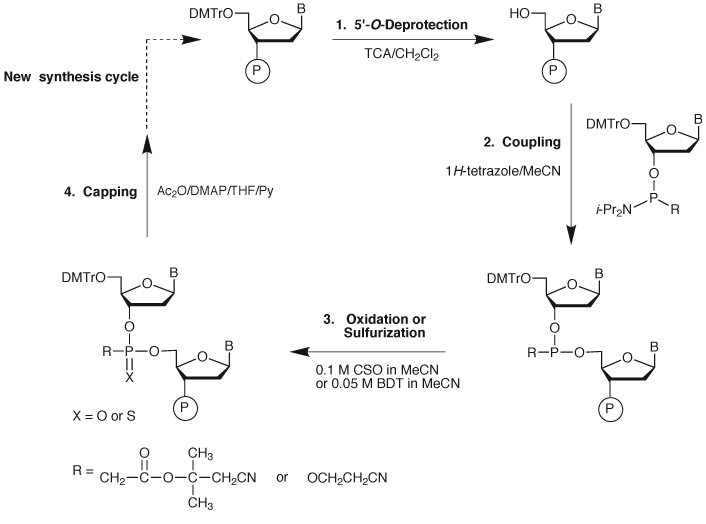Glen Report 20.22: Synthesis, Cleavage and Deprotection of PACE Oligonucleotides
Synthesis
The general scheme for synthesis is shown in Figure 6. The structures of the four monomers are shown in Figure 7. The phosphonoacetates are fully soluble in acetonitrile at a recommended concentration of 0.1M and are compatible with standard DNA synthesizers. A recommended coupling time of 33.3 minutes with 1H-Tetrazole is necessary when using the standard protocol. A modified LV cycle for AB instruments that reduces coupling time to 15 minutes with 1H-Tetrazole is available on our website.
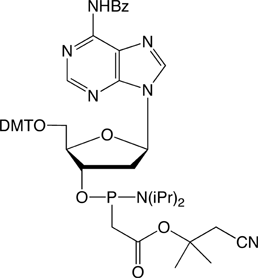
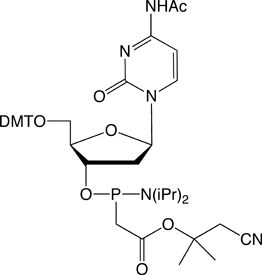
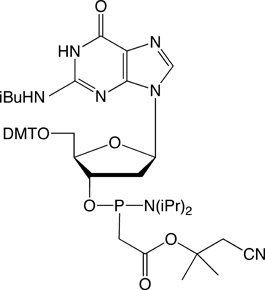
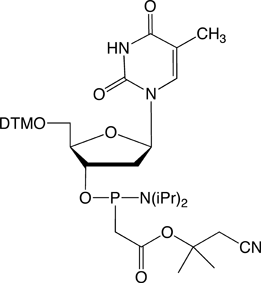
Oxidation must precede capping in the synthesis cycle. Reagents for oxidation depend on the type of synthesis. For fully modified oligos, we recommend the non-aqueous oxidizer camphorsulfonyloxaziridine (CSO) as a 0.1M solution. For mixed phosphodiester and phosphonoacetate modified oligos, a 0.5M CSO solution is recommended. Low water oxidizer, 40-4032, is an alternative oxidizing reagent although it has been reported that this can result in conversion of a small percentage of the phosphonoacetate to the phosphodiester. We also recommend the use of the Cap Mix B with DMAP (40-4020) instead of the standard Cap Mix B containing 1-Methylimidazole.
Cleavage and Deprotection
The standard protocol for cleavage and deprotection requires a two step method with pretreatment using 1,8-Diazabicyclo[5.4.0]undec-7-ene (DBU) and subsequent cleavage using methylamine. The DBU is used to deprotect the dimethylcyanoethyl (DMCE) protecting groups and to prevent alkylation of the bases during deprotection. Cleavage with 40% methylamine in water is recommended and we have also had good results when using AMA deprotection.
- Prepare a 1.5% DBU solution in anhydrous acetonitrile.
- Load a 1 mL plastic syringe with 1mL of solution.
- Connect to one luer fitting of the synthesis column.
- Connect a clean 1 mL syringe to the other luer fitting.
- Carefully pass the solution through the column a few times.
- Allow to stand at room temperature for 60 minutes.
- Discard solution from syringe into waste.
- Rinse with 3 x 5 mL of anhydrous acetonitrile and dry under stream of argon.
- Carefully transfer CPG to clean 4 mL vial.
- Add 1 mL 40% aqueous methylamine and heat to 55°C for 15 minutes. Avoid prolonged deprotection times.
Purification and Desalting
DMT-On oligos can be purified using the standard Glen-Pak™ protocol. DMT-Off Oligos can be desalted using ethanol or butanol precipitation. The phosphonoacetate modified oligos form diastereomers that can make purification difficult by Ion-Exchange or RP HPLC. An oligo containing multiple incorporations will produce broad peaks on the chromatogram. If HPLC purification is desired, we recommend DMT-On purification by reverse phase HPLC with subsequent removal of the DMT protecting group.
Intellectual Property
These products are covered by patents, US 6,693,187 and 7,067,641, and patents pending owned by Metasense Technologies. Purchase of all or any of these products includes a limited license to use the products solely for the manufacture of oligonucleotides for research use only. This license specifically excludes the use of the product or oligonucleotides containing the product for: (a) therapeutic or diagnostic applications (including kits, pools, libraries and other products or services that incorporate oligonucleotides containing the product), (b) any in vivo toxicity/safety study in support of an investigational new drug application (or foreign counterpart), or (c) resale (including sale of kits, pools, libraries and other products or services that incorporate the product or oligonucleotides containing the product). If such activities have commercial application, a separate license is required from Metasense Technologies. Neither the product nor any product created through its use may be used in human clinical trials.
A simple agreement must be signed before end-users and custom oligo services may purchase these products for use as defined above.
Product Information
PACE Phosphoramidites have been discontinued.
- Glen Report 20.21: Phosphonoacetate (PACE) Oligonucleotides Introduction
- Glen Report 20.22: Synthesis, Cleavage and Deprotection of PACE Oligonucleotides
- Glen Report 20.23: Novel Reagents for Modification and Labelling
- Glen Report 20.24: Deprotection - Volume 1 - Deprotect to Completion
- Glen Report 20.25: New Universal Support - Glen UnySupport
- Glen Report 20.26: New Products for Attachment of Oligonucleotides on Gold Surfaces
- Glen Report 20.27: 5'-Dichloro-Dimethoxy-Fluorescein (JOE™) Phosphoramidite
- Glen Report 20.28: Site-specific incorporation of functional components into RNA by transcription using unnatural base pair systems


